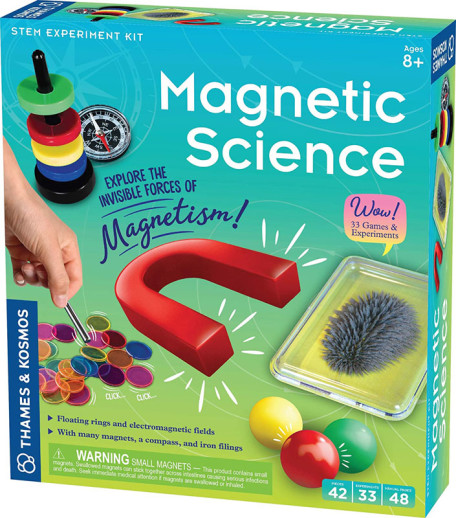We use cookies to make your experience better. To comply with the new e-Privacy directive, we need to ask for your consent to set the cookies. Learn more.
Magnetic Science Kit
The instruction manual contained in this kit is an education in itself, but for children there's nothing quite like getting their hands involved in seeing for themselves how things work. As you work your way through the activities in this kit with your children, they'll learn all about magnets, the way they're attracted to iron, poles, compasses, magnetic force fields, and electromagnets. Then at the end, they'll get to have some fun with magnet gamesfor a total of 33 experiments to do! The kit includes ring, block, and ball magnets; plastic chips; a horseshoe and bar magnet set; compass; iron powder; an iron rod; wire; a polystyrene disk; and a cardboard strip for one of the games. Additional items are needed for some of the experiments, all of which are normal household items. Chad
Explore the invisible and amazing power of magnets with 33 engaging experiments and games. This science experiment kit contains many magnets of different shapes and sizes, and a variety of other components with which you can explore this classic scientific subject.
Experiment to determine which materials are magnetic and which are not. Learn about magnetic poles and magnetic fields. Discover how Earth behaves like one giant magnet, and how we use compasses to take advantage of this phenomenon to determine which way is north. Conduct a series of experiments to learn first hand how magnets behave and interact under different conditions. Make invisible magnetic fields visible using iron filings in an enclosed transparent box. Build an electromagnet to learn how electricity relates to magnetism. Finally, have some fun with what you have learned by playing some games with magnets. The full-color, 48-page manual guides your experiments with illustrated step-by-step instructions.
| Product Format: | Kit |
|---|---|
| Grades: | 3-AD |
| Brand: | Thames and Kosmos |
| EAN/UPC: | 814743010406 |
| Length in Inches: | 11.125 |
| Width in Inches: | 10.125 |
| Height in Inches: | 2.625 |
| Weight in Pounds: | 1.3625 |
Be the first to review this item
- Start typing and we'll see if it was already asked and answered.
- If there aren't already some matches, submit a new question.
- You'll get fast answers from customers who really own the item(s) and from our product experts. (About half the time you'll get an answer in under 2 hours!)
- Which items will best meet your needs
- What customers who own an item think of it
- How to use, fix, or take care of an item
- Product information
- General advice related to the types of products we sell
- Our store policies
For questions about an order you have placed, please contact customer support directly.












something fun for my kids to learn
A kit that actually includes the magnetics and a variety too. Looks like lots to learn from.